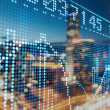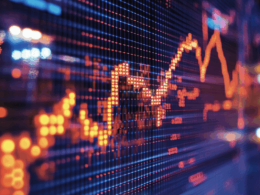by Erik Ristuben, Russell Investments
On the latest edition of Market Week in Review, Chief Investment Strategist Erik Ristuben and Director of Institutional Investment Solutions, Greg Coffey, discussed the rise in U.S. government bond yields, the U.S. employment report for December and the number of potential U.S. Federal Reserve (Fed) rate hikes in store this year.
U.S. government bond yields soar to start 2022. What’s driving the rapid rise?
The first week of 2022 was marked by a dramatic rise in U.S. interest rates, Ristuben said, noting that the yield on the benchmark 10-year Treasury note had climbed to 1.77% as of midday Pacific time on Jan. 7—up 26 basis points from the end of 2021. The uptick in rates actually began on Jan. 3, two days before the release of the Fed’s hawkish December meeting minutes, he said, citing three possible reasons for the sudden surge.
“I believe that the first factor was an easing in concern over the potential impacts of the omicron variant of COVID-19,” Ristuben stated, noting that current medical evidence indicates the variant is less severe than other mutations of the virus. In addition, data in recent weeks has shown that COVID-19 vaccines and booster shots are very effective at preventing omicron infections from leading to hospitalization and/or serious illness, he added.
Together, these reports led to a degree of relief for markets, which had initially feared that omicron could inflict a fair amount of damage to the global economy, Ristuben said. This, in turn, helped fuel the selloff in government bonds as investor confidence about the health of the economy rebounded, he noted.
The second factor behind the spike in bond yields can likely be attributed to the raising of the U.S. debt ceiling, or federal borrowing limit, this past December, Ristuben said. “Before Congress reached a deal to lift the debt ceiling, the Treasury Department was delaying issuing new debt, which led to a supply problem in terms of debt issuance,” he explained. With the Treasury now issuing more debt, supply has increased, leading to falling prices and rising rates, Ristuben said.
The third likely reason why yields are soaring is due to the Fed’s reduction in monthly bond purchases as it unwinds, or tapers, its quantitative easing program, he stated. “Taken together, I believe these three factors offer a pretty good explanation of why rates have risen so quickly,” Ristuben concluded.
U.S. unemployment rate falls below 4%
Turning to the status of the U.S. labor market, Ristuben noted that the just-released December employment report fell short of consensus expectations, with 199,000 additional jobs added, versus expectations for approximately 422,000 new nonfarm payrolls.
“At first glance, this headline number, which comes from the Department of Labor’s establishment survey that measures nonfarm employment, suggests that hiring last month wasn’t that impressive. But a look at the second survey used to compile the December report—the household survey—shows that the unemployment rate fell pretty meaningfully last month, dropping to 3.9%,” he explained. This is the second straight month that the household survey revealed a dramatic improvement in U.S. unemployment, Ristuben said, noting that the unemployment rate previously plunged from 4.6% in October to 4.2% in November.
Our Fed rate hike forecast for 2022—and why it differs from market expectations
The release of the Fed’s minutes from its Dec. 14-15 meeting make it very clear that the central bank plans to begin lifting rates this year, Ristuben said, with markets currently pricing in a 90% probability of a rate increase in mid-March. In addition, markets—and a majority of FOMC (Federal Open Market Committee) members—are also projecting a total of three rate hikes by the end of 2022, he observed.
“At Russell Investments, we’re not as convinced that the Fed will hike three times this year,” Ristuben stated, explaining that he and the team of strategists expect core inflation to decline to 2.0% by year-end. By contrast, the FOMC anticipates inflation to subside less—falling to a level of 2.7% at the end of 2022, he said.
“If inflation only drops to 2.7% at year-end, then I do think we’ll probably see three rate hikes this year—but if it drops off to our forecast level of 2.0%, I think we’ll see fewer than three,” Ristuben remarked. He explained that, in his viewpoint, inflation is more likely to decrease to a 2.0% level due to a combination of improvements in the supply chain, moderating economic growth and base effects—the term used to describe the distortions in inflation data that occur when current numbers are compared to extremely high (or low) numbers from the past year.
That said, Ristuben noted it’s important to understand that initial rate increases by the Fed very rarely have significant long-term impacts on equities. “At the end of the day, the Fed raises rates when economic conditions have improved so much that the economy no longer needs monetary stimulus—and that’s generally a good thing,” he concluded.















